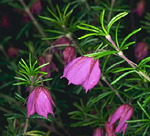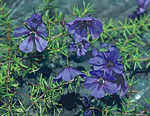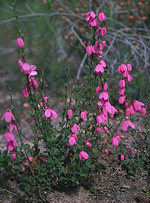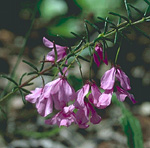 |
This is a small family endemic to Australia, found in heathlands and heathy forests usually on sandy soils and never far inland, from south-east Queensland to Tasmania and south-eastern South Australia, and in the south-west of Western Australia.
Characteristic features of the family Tremandraceae in Australia include: - small shrubs, often heath-like with slender, little-branched stems. Sometimes leafless, often with simple, glandular or stellate hairs
- leaves simple, opposite, alternate or whorled
- flowers showy, pink, purple or white, bisexual, solitary in the upper leaf axils and often nodding.
- sepals and petals 4 or 5, free
- stamens twice as many as the petals, with short filaments and large, cylindrical, often dark-coloured anthers which are basifixed and open by a terminal pore
- ovary superior, developing into a flattened, 2-valved capsule
Description
Evergreen shrubs. Perennating by rhizomes. Vegetative reproduction
absent, or by rhizomes. Leaves sometimes ±absent. Stem internodes
terete, strongly flattened or distinctly angular. Internal secretions
not obvious. Plants with simple or stellate, glandular or non-glandular,
unicellular hairs. Leaves sometimes much reduced (i.e. to scales, etc.),
or entirely absent, alternate and spiral, or opposite, or in whorls of
3–7 or more, petiolate, subsessile or sessile. Stipules absent. Lamina
simple, symmetric, filiform, acicular, subulate, linear, lanceolate, ovate,
elliptic, oblanceolate, obovate or orbicular; base cuneate, rounded or
cordate; margins entire or dentate, ±flat, revolute or recurved;
veins pinnate, with midrib conspicuous or inconspicuous, and the tertiary
venation not reticulate; surfaces not punctate; herbaceous. All the flowers
bisexual. Inflorescences terminal or axillary, consisting of racemes or
solitary flowers. Bracts present or absent. Pollination by insects. Flowers
odourless or fragrant, stalked. Floral disc present or absent; nectaries
absent. Perianth regular, of 2 dissimilar whorls, valvate in bud. Calyx
segments free or fused, with 4–5 sepals or lobes, herbaceous. Corolla
segments free, of 4–5 petals, alternating with the sepals or calyx lobes,
pink, magenta or blue, or rarely white, without contrasting markings,
membranous; claws absent; lobes ±entire. Fertile stamens 8 or 10,
both opposite to and alternating with the sepals or calyx lobes, free
of the corolla, free of the ovary and style, distinct from each other,
grouped or fused into bundles or fused by their filaments into an open
or closed tube, all ±equal. Anthers basifixed, not versatile, opening
by terminal pores; 2 or 4-celled. Ovary superior and sessile. Carpels
2, fused; ovary with 2 locules. Style terminal, single and unbranched,
or branching from the base; stigma papillae present. Ovules 1–10 per locule,
stalked; placentation apical or axile. Fruit a dry, dehiscent septicidal
or loculicidal capsule; the perianth on the maturing fruit deciduous,
or dry and persistent. Disseminule macro-surface featureless, or with
straight hairs; micro-surface ±smooth, brown, glossy or dull. Seeds
2–20 per fruit. Aril present or absent. Cotyledons 2. Embryo straight.
(Note: this description has been generated from the coded data compiled
for the key. Any errors in the key data will be reflected in the descriptions.)
A treatment of the family Tremandraceae has not yet been published in the Flora of Australia. It will appear in Volume 24.
Australian genera of Tremandraceae (as recognised for the Flora of Australia)
Platytheca
Tetratheca
Tremandra

|
  |

Platytheca galioides (flowers)
Photo: M.Fagg © ANBG

Platytheca juniperina (flowers)
Photo: F.Humphreys © ANBG

Tetratheca ciliata (flowers)
Photo: D.Greig © ANBG

Tetratheca neglecta (flowers)
Photo: D.Greig © ANBG

|
 |
|